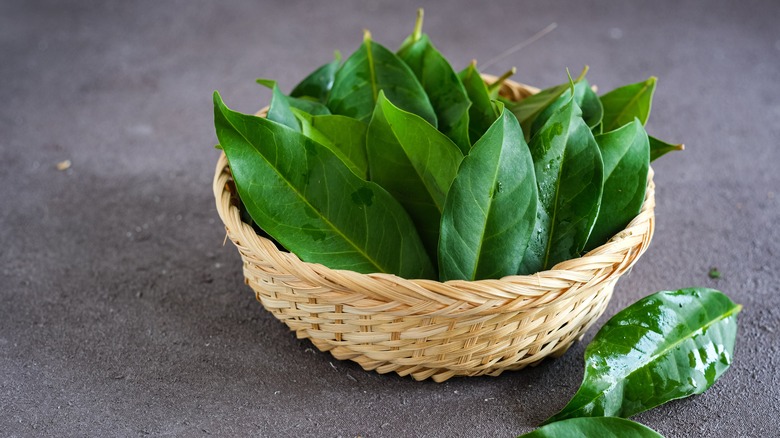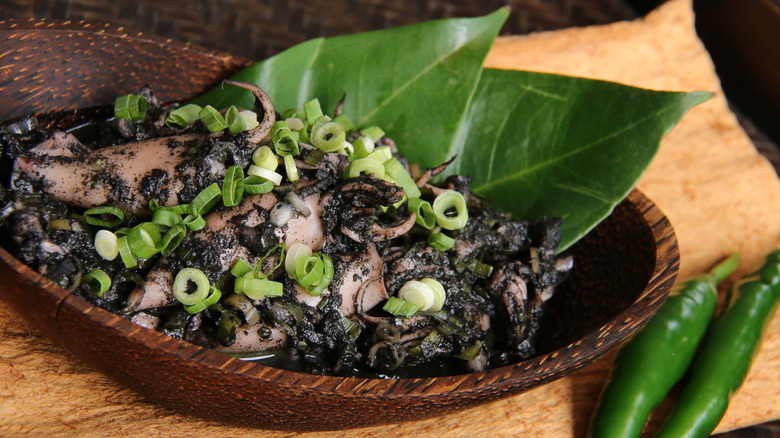Why You Need To Keep Indonesian Bay Leaves In Your Pantry
Soto ayam, rendang, babi kecap, nasi uduk, and other Indonesian dishes have a rich, complex flavor that tantalizes the senses. Their distinct aroma is often due to the use of fresh herbs and spices, such as turmeric, garlic, coriander, and lemongrass. A key ingredient is Syzygium polyanthum, or Indonesian bay leaf. With its earthy flavor, this herb complements meat dishes and vegetable soups, but it also goes well with chicken, fish, lamb, or rice.
A good example is nasi uduk, or Indonesian coconut rice, which calls for coconut milk, rice, garlic, shallots, galangal, and bay leaves, among other ingredients. Daun salam, or Indonesian bay leaves, will add depth and complexity to this hearty dish. Their flavor is slightly sweet and slightly bitter, with earthy notes. The spice can also make steak tender and enhance its overall taste.
Note that Indonesian bay leaves are not the same as Indian bay leaves. The latter grow in Northeast India and have a cinnamon-like flavor with hints of cloves. Also, salam leaves taste differently than European bay leaves and cannot be used interchangeably in recipes.
Daun salam, a versatile spice with potential health benefits
Indonesian bay leaves have a mild aroma that can complement savory dishes without overpowering the other ingredients. They can be used fresh or dried in sauces, curries, stews, fried rice, and fish soups, offering both flavor and nutrition. This versatile spice is rich in quercetin and may protect against diabetes, according to a 2020 study published in the Biodiversitas Journal of Biological Diversity. Quercetin, a flavonoid with anti-inflammatory effects, may also benefit heart health and ease the symptoms of interstitial cystitis, prostatitis, and allergies.
Daun salam can be used in herbal teas, too. Indonesian bay leaf tea is chock-full of flavonoids, tannins, and other antioxidants, reports a 2022 study featured in Food Research. Indonesian people also use this herb as a natural remedy for gastritis, high blood sugar, and stomach pain. Scientists recommend brewing the leaves at 176 degrees Fahrenheit for 30 minutes to boost their antioxidant levels.
Some studies also suggest that salam leaves may benefit people with arthritis and elevated uric acid, notes a 2019 review presented in the AIP Conference Proceedings. As the researchers note, the plant contains volatile oils, saponins, alkaloids, and other phytonutrients that support human health. These compounds protect against oxidative stress and may help prevent disease.
How to use Indonesian bay leaves
Bay leaves should be removed from dishes before serving; they're difficult to chew. (The flavor will still transfer to the food you're cooking and add a pleasant fragrance.) You can also add this herb to jamu, teh talua, teas, and other homemade drinks. The plant isn't widely available in U.S. stores but can be purchased online. Most vendors sell dried Indonesian bay leaves, which have no particular flavor or scent. Therefore, you'll have to cook them to bring out their flavor.
One option is to boil the leaves in coconut milk before using them in cooked dishes. Alternatively, you can fry them in oil and then add them to stews, fish soups, steaks, or rice. When cooking sauces or curries, you can add the whole dried leaves to the mixture and remove them before serving the dish.
For example, you could start by using this ingredient in nasi goreng, or Indonesian fried rice. This dish has several variations, but most recipes call for rice, chicken, sweet soy sauce, garlic, eggs, chili sauce, and other common ingredients. You can also add Indonesian bay leaves to nasi kuning (turmeric rice), gulai kambing (lamb curry), vegetable soups, and seafood dishes.


